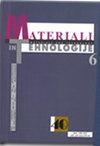E350 HSLA 钢磁性焊接接头的实验研究
IF 0.6
4区 材料科学
Q4 MATERIALS SCIENCE, MULTIDISCIPLINARY
引用次数: 0
摘要
活性助焊剂已被成功用于提高钨极惰性气体(TIG)焊接的熔透性,而 TIG 通常是一种熔透性较低的焊接工艺。但同样的活性助焊剂用于金属活性气体(MAG)焊接时,其熔透性只得到适度改善。因此,只有少数研究文章报道了活性焊剂 MAG 焊接。氩弧焊修整是一种焊后处理工艺,旨在提高焊接接头的疲劳寿命。活性焊剂与氩弧焊修整一起使用的情况尚未见报道。在这项工作中,对使用活性助焊剂涂层的 MAG 焊接和趾部 TIG 修整的 E350 钢的冶金变化及其对疲劳寿命的影响进行了实验研究。研究讨论了各种焊接条件引起的冶金变化及其对焊接接头疲劳寿命的影响。焊接条件分为:无焊缝 (AW)、带焊剂涂层的焊缝 (FW)、带氩弧焊修整的焊缝 (AWT) 和带氩弧焊修整的焊剂焊缝 (FWT)。研究了在接近屈服应力(屈服应力的 80% 至 90%)的应力范围内进行的疲劳试验。与 AW 接头相比,AWT 和 FWT 接头的疲劳寿命分别提高了 60% 至 80% 和 69% 至 103%。而 FW 接头的疲劳寿命缩短了 10% 至 17%。使用电子显微镜进行调查后发现,这些疲劳行为背后的原因包括:使用焊剂和氩弧焊修整引起的晶粒大小变化和相变,以及氩弧焊修整引起的焊趾半径变化和使用焊剂引起的额外渗透导致的根部强化。在这项工作中,我们努力寻找一种结合两种技术提高焊接接头疲劳寿命的新方法。活性助焊剂用于改善熔透,而氩弧焊修整则用于减少应力集中。这一新技术组合大大提高了焊缝的疲劳寿命,从而降低了焊接接头的维护成本,延长了使用寿命。本文章由计算机程序翻译,如有差异,请以英文原文为准。
EXPERIMENTAL STUDY ON MAG WELDED E350 HSLA STEEL JOINTS
Activated flux has been used successfully to improve the penetration of Tungsten Inert-Gas (TIG) welding, which is normally a welding process with low penetration. But the same activated flux when used for Metal Active Gas (MAG) welding showed a moderate improvement in penetration. Hence only a few research articles reported on activated flux MAG welding. TIG dressing is a post-weld treatment intended to improve the fatigue life of welded joints. The use of activated flux along with TIG dressing were not yet reported. In this work, an experimental study was conducted on the metallurgical changes and their effects on fatigue life in E350 steel welded by MAG welding with activated flux coating as well as toe TIG dressing. The metallurgical changes induced by various weld conditions and the effect on the fatigue life of welded joints were discussed. Welding conditions were categorised as: as weld (AW), weld with flux coating (FW), weld with TIG dressing (AWT), and flux weld with TIG dressing (FWT). Fatigue tests at stress ranges closer to the yield stress (80 % to 90 % of yield) were studied. In comparison with AW joints, the AWT and FWT showed a fatigue-life improvement of 60 % to 80 %, and 69 % to 103 % respectively. Whereas the FW joints showed 10 % to 17 % deterioration in fatigue life. Upon investigation with electron microscopy it was found that the variation in grain sizes and phase changes induced by the usage of flux and TIG dressing, as well as the changes in weld toe radius by TIG dressing and root strengthening due to extra penetration induced by the use of flux were the reasons behind these fatigue behaviours. In this work a novel effort is made to find a way to improve the fatigue life of a welded joint with a combination of two techniques. The activated flux is used to improve the penetration, whereas TIG dressing is performed to reduce the stress concentration. This new combination of techniques has improved the fatigue life of the weld significantly, which can lead to reduced maintenance costs of welded joints and a longer life.
求助全文
通过发布文献求助,成功后即可免费获取论文全文。
去求助
来源期刊

Materiali in tehnologije
工程技术-材料科学:综合
CiteScore
1.30
自引率
0.00%
发文量
73
审稿时长
4-8 weeks
期刊介绍:
The journal MATERIALI IN TEHNOLOGIJE/MATERIALS AND TECHNOLOGY is a scientific journal, devoted to original papers and review scientific papers concerned with the areas of fundamental and applied science and technology. Topics of particular interest include metallic materials, inorganic materials, polymers, vacuum technique and lately nanomaterials.
 求助内容:
求助内容: 应助结果提醒方式:
应助结果提醒方式:


